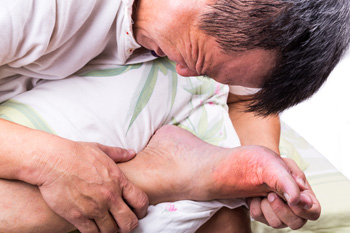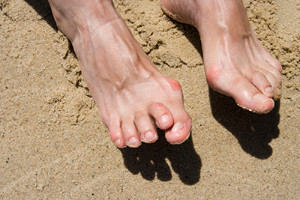February 2020
Why Does Gout Develop?
 A form of arthritis that generally affects more men than women is referred to as gout. It typically targets the big toe, and common symptoms can include intense pain, swelling, and the toe may appear red or inflamed. This uncomfortable condition may be caused by elevated uric acid levels in the bloodstream. When specific types of foods are eaten, the uric acid levels may increase as a result of excess purines. These foods can include shellfish, red meat, and drinks that have large amounts of sugar. Crystals form in and around the joints of the feet, and this may cause severe pain. There can be existing health conditions that may lead to the development of gout. These can consist of diabetes, high blood pressure, and obesity. If you are experiencing gout, it is strongly advised that you are under the care of a podiatrist who can properly treat this condition, and help you to implement a healthy lifestyle.
A form of arthritis that generally affects more men than women is referred to as gout. It typically targets the big toe, and common symptoms can include intense pain, swelling, and the toe may appear red or inflamed. This uncomfortable condition may be caused by elevated uric acid levels in the bloodstream. When specific types of foods are eaten, the uric acid levels may increase as a result of excess purines. These foods can include shellfish, red meat, and drinks that have large amounts of sugar. Crystals form in and around the joints of the feet, and this may cause severe pain. There can be existing health conditions that may lead to the development of gout. These can consist of diabetes, high blood pressure, and obesity. If you are experiencing gout, it is strongly advised that you are under the care of a podiatrist who can properly treat this condition, and help you to implement a healthy lifestyle.
Gout is a painful condition that can be treated. If you are seeking treatment, contact Dr. Scott Shrem from Garden State Foot & Ankle Center. Our doctor will treat your foot and ankle needs.
What Is Gout?
Gout is a form of arthritis that is characterized by sudden, severe attacks of pain, redness, and tenderness in the joints. The condition usually affects the joint at the base of the big toe. A gout attack can occur at any random time, such as the middle of the night while you are asleep.
Symptoms
- Intense Joint Pain - Usually around the large joint of your big toe, and it most severe within the first four to twelve hours
- Lingering Discomfort - Joint discomfort may last from a few days to a few weeks
- Inflammation and Redness -Affected joints may become swollen, tender, warm and red
- Limited Range of Motion - May experience a decrease in joint mobility
Risk Factors
- Genetics - If family members have gout, you’re more likely to have it
- Medications - Diuretic medications can raise uric acid levels
- Gender/Age - Gout is more common in men until the age of 60. It is believed that estrogen protects women until that point
- Diet - Eating red meat and shellfish increases your risk
- Alcohol - Having more than two alcoholic drinks per day increases your risk
- Obesity - Obese people are at a higher risk for gout
Prior to visiting your podiatrist to receive treatment for gout, there are a few things you should do beforehand. If you have gout you should write down your symptoms--including when they started and how often you experience them, important medical information you may have, and any questions you may have. Writing down these three things will help your podiatrist in assessing your specific situation so that he or she may provide the best route of treatment for you.
If you have any questions, please feel free to contact our office located in Hazlet, NJ . We offer the newest diagnostic and treatment technologies for all your foot care needs.
What Are the Symptoms of Hammertoe?
 When the middle joint in a toe looks deformed, it may be indicative of a condition that is known as hammertoe. Hammertoe occurs as a result of an imbalance in the soft tissues of the affected toe, and may cause swelling and discomfort. Additional symptoms may consist of redness surrounding the toe, and difficulty moving or straightening the toe. The affected toe typically bends downward, resembling a hammer, and a corn may form on top of it as shoes are worn as well. This condition may happen from a genetic muscle imbalance, if shoes that are worn have inadequate room for the toes to move freely in, or if the toe has endured an injury. There are several ways to treat hammertoe. If you are afflicted with this condition, it is strongly advised that you seek the counsel of a podiatrist who can begin the best type of treatment for you.
When the middle joint in a toe looks deformed, it may be indicative of a condition that is known as hammertoe. Hammertoe occurs as a result of an imbalance in the soft tissues of the affected toe, and may cause swelling and discomfort. Additional symptoms may consist of redness surrounding the toe, and difficulty moving or straightening the toe. The affected toe typically bends downward, resembling a hammer, and a corn may form on top of it as shoes are worn as well. This condition may happen from a genetic muscle imbalance, if shoes that are worn have inadequate room for the toes to move freely in, or if the toe has endured an injury. There are several ways to treat hammertoe. If you are afflicted with this condition, it is strongly advised that you seek the counsel of a podiatrist who can begin the best type of treatment for you.
Hammertoe
Hammertoes can be a painful condition to live with. For more information, contact Dr. Scott Shrem from Garden State Foot & Ankle Center. Our doctor will answer any of your foot- and ankle-related questions.
Hammertoe is a foot deformity that affects the joints of the second, third, fourth, or fifth toes of your feet. It is a painful foot condition in which these toes curl and arch up, which can often lead to pain when wearing footwear.
Symptoms
- Pain in the affected toes
- Development of corns or calluses due to friction
- Inflammation
- Redness
- Contracture of the toes
Causes
Genetics – People who are genetically predisposed to hammertoe are often more susceptible
Arthritis – Because arthritis affects the joints in your toes, further deformities stemming from arthritis can occur
Trauma – Direct trauma to the toes could potentially lead to hammertoe
Ill-fitting shoes – Undue pressure on the front of the toes from ill-fitting shoes can potentially lead to the development of hammertoe
Treatment
Orthotics – Custom made inserts can be used to help relieve pressure placed on the toes and therefore relieve some of the pain associated with it
Medications – Oral medications such as anti-inflammatories or NSAIDs could be used to treat the pain and inflammation hammertoes causes. Injections of corticosteroids are also sometimes used
Surgery – In more severe cases where the hammertoes have become more rigid, foot surgery is a potential option
If you have any questions please contact our office located in Hazlet, NJ . We offer the newest diagnostic and treatment technologies for all your foot and ankle needs.
Possible Dangers of Wearing High Heels
 Many women enjoy wearing high heels. They can make the feet and legs look slender, as well as add style to many clothing choices. Despite their popularity, they have been linked to causing damage to the feet. It may be easier to trip and sprain an ankle while wearing this type of shoe, and the muscles in the feet may become strained as well. Additionally, wearing high heels that do not have ample room for the toes to move freely in may cause bunions or hammertoes to develop. Some of these conditions may be prevented by alternating between high heels, and shoes that have adequate support. If you would like more information about how high heels can affect the feet, please consult with a podiatrist.
Many women enjoy wearing high heels. They can make the feet and legs look slender, as well as add style to many clothing choices. Despite their popularity, they have been linked to causing damage to the feet. It may be easier to trip and sprain an ankle while wearing this type of shoe, and the muscles in the feet may become strained as well. Additionally, wearing high heels that do not have ample room for the toes to move freely in may cause bunions or hammertoes to develop. Some of these conditions may be prevented by alternating between high heels, and shoes that have adequate support. If you would like more information about how high heels can affect the feet, please consult with a podiatrist.
High heels have a history of causing foot and ankle problems. If you have any concerns about your feet or ankles, contact Dr. Scott Shrem from Garden State Foot & Ankle Center. Our doctor can provide the care you need to keep you pain-free and on your feet.
Effects of High Heels on the Feet
High heels are popular shoes among women because of their many styles and societal appeal. Despite this, high heels can still cause many health problems if worn too frequently.
Which Parts of My Body Will Be Affected by High Heels?
- Ankle Joints
- Achilles Tendon – May shorten and stiffen with prolonged wear
- Balls of the Feet
- Knees – Heels cause the knees to bend constantly, creating stress on them
- Back – They decrease the spine’s ability to absorb shock, which may lead to back pain. The vertebrae of the lower back may compress.
What Kinds of Foot Problems Can Develop from Wearing High Heels?
- Corns
- Calluses
- Hammertoe
- Bunions
- Morton’s Neuroma
- Plantar Fasciitis
How Can I Still Wear High Heels and Maintain Foot Health?
If you want to wear high heeled shoes, make sure that you are not wearing them every day, as this will help prevent long term physical problems. Try wearing thicker heels as opposed to stilettos to distribute weight more evenly across the feet. Always make sure you are wearing the proper shoes for the right occasion, such as sneakers for exercising. If you walk to work, try carrying your heels with you and changing into them once you arrive at work. Adding inserts to your heels can help cushion your feet and absorb shock. Full foot inserts or metatarsal pads are available.
If you have any questions please feel free to contact our office located in Hazlet, NJ . We offer the newest diagnostic and treatment technologies for all your foot and ankle needs.
How Ankle Sprains Can Cause You Pain
 There are many different reasons for a person to experience ankle pain. One of the most common reasons is due to having an ankle sprain. While ankle sprains are quite typical within the sports community, they may still occur during everyday activities. If the ligaments of the ankle are stretched much greater than normal, they will become injured. This is typically caused by the foot turning inward. Along with pain, other common symptoms related to ankle sprains include inflammation, swelling, redness, and warmth near the affected area. In order to make sure you’re correctly caring for your ankle pain, we recommend you consult with a podiatrist for a proper diagnosis and advised treatment plan.
There are many different reasons for a person to experience ankle pain. One of the most common reasons is due to having an ankle sprain. While ankle sprains are quite typical within the sports community, they may still occur during everyday activities. If the ligaments of the ankle are stretched much greater than normal, they will become injured. This is typically caused by the foot turning inward. Along with pain, other common symptoms related to ankle sprains include inflammation, swelling, redness, and warmth near the affected area. In order to make sure you’re correctly caring for your ankle pain, we recommend you consult with a podiatrist for a proper diagnosis and advised treatment plan.
Ankle pain can be caused by a number of problems and may be potentially serious. If you have ankle pain, consult with Dr. Scott Shrem from Garden State Foot & Ankle Center. Our doctor will assess your condition and provide you with quality foot and ankle treatment.
Ankle pain is any condition that causes pain in the ankle. Due to the fact that the ankle consists of tendons, muscles, bones, and ligaments, ankle pain can come from a number of different conditions.
Causes
The most common causes of ankle pain include:
- Types of arthritis (rheumatoid, osteoarthritis, and gout)
- Ankle sprains
- Broken ankles
- Achilles tendinitis
- Achilles tendon rupture
- Stress fractures
- Bursitis
- Tarsal tunnel syndrome
- Plantar fasciitis
Symptoms
Symptoms of ankle injury vary based upon the condition. Pain may include general pain and discomfort, swelling, aching, redness, bruising, burning or stabbing sensations, and/or loss of sensation.
Diagnosis
Due to the wide variety of potential causes of ankle pain, podiatrists will utilize a number of different methods to properly diagnose ankle pain. This can include asking for personal and family medical histories and of any recent injuries. Further diagnosis may include sensation tests, a physical examination, and potentially x-rays or other imaging tests.
Treatment
Just as the range of causes varies widely, so do treatments. Some more common treatments are rest, ice packs, keeping pressure off the foot, orthotics and braces, medication for inflammation and pain, and surgery.
If you have any questions, please feel free to contact our office located in Hazlet, NJ . We offer the newest diagnostic and treatment technologies for all your foot care needs.
Gout Pain Can Be Managed
Blog Archives
- April 2025
- March 2025
- February 2025
- January 2025
- December 2024
- November 2024
- October 2024
- September 2024
- August 2024
- July 2024
- June 2024
- May 2024
- April 2024
- March 2024
- February 2024
- January 2024
- December 2023
- November 2023
- October 2023
- September 2023
- August 2023
- July 2023
- June 2023
- May 2023
- April 2023
- March 2023
- February 2023
- January 2023
- December 2022
- November 2022
- October 2022
- September 2022
- August 2022
- July 2022
- June 2022
- May 2022
- April 2022
- March 2022
- February 2022
- January 2022
- December 2021
- November 2021
- October 2021
- September 2021
- August 2021
- July 2021
- June 2021
- May 2021
- April 2021
- March 2021
- February 2021
- January 2021
- December 2020
- November 2020
- October 2020
- September 2020
- August 2020
- July 2020
- June 2020
- May 2020
- April 2020
- March 2020
- February 2020
- January 2020
- December 2019
- November 2019
- October 2019
- September 2019
- August 2019
- July 2019
- June 2019
- May 2019
- April 2019
- March 2019
- February 2019
- January 2019
- December 2018
- November 2018
- October 2018
- September 2018
- August 2018
- July 2018
- June 2018
- May 2018
- April 2018
- March 2018









